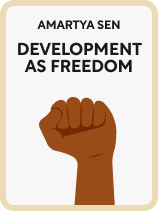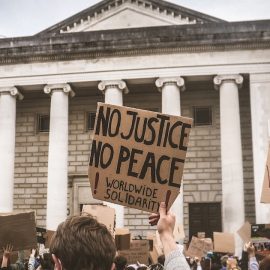

This article is an excerpt from the Shortform book guide to "Development as Freedom" by Amartya Sen. Shortform has the world's best summaries and analyses of books you should be reading.
Like this article? Sign up for a free trial here .
What are the types of freedom, according to Amartya Sen? Why is it important for governments to support and instill these types of freedoms into their countries?
In Development as Freedom, Amartya Sen makes a philosophical case that freedom-centered development can create a better society and economy. The types of freedom that are essential for a person’s potential are democratic rights, commercial liberties, public provisions, ethical guardrails, and safety nets.
Check out what Sen believes are the most important freedoms a person should have.
Five Types of Freedom
What are the types of freedom? Sen cites five rights that advance a person’s potential:
- Democratic rights
- Commercial liberties
- Public provisions
- Ethical guardrails
- Safety nets
(Shortform note: Sen’s list of five freedoms is similar to the four freedoms that Franklin D. Roosevelt laid out in a famous speech in 1941. Roosevelt argued the four fundamental freedoms were: freedom of speech, freedom of worship, freedom from want, and freedom from fear. Like Sen, Roosevelt believed it was the government’s obligation to provide material support and national security to people, in addition to securing their liberties.)
#1: Democratic Rights
Sun explains that democratic rights (or political freedoms) are mostly synonymous with the typical civil rights of liberal democracy. They include:
- The ability to choose who governs and on what principles
- The right to freedom of expression and the press
- The right to form and choose among political parties
- The right to criticize authority figures
#2: Commercial Liberties
By commercial liberties, Sen means the freedom of individuals to produce, exchange, and consume their choice of goods and services. Here, Sen focuses on the ability to engage in economic activity free from arbitrary constraints, such as government price controls and forced labor. The right to access financial institutions and credit is also part of economic freedom. This access is crucial because it gives low-income people a chance to earn interest through savings, or to receive loans for new business ventures.
#3: Public Provisions
Public provisions refer to having access to services that enable people to live better—such as education and health care. These provisions allow people to better enjoy other types of freedoms. For example, access to education provides literacy, which is crucial to exercising political freedoms because it allows citizens to make more informed decisions; good health is important to commercial freedom because it allows people to be more productive workers.
#4: Ethical Guardrails
Ethical guardrails create openness and trust in social interactions, especially commerce. According to Sen, ethical guardrails include the “right to disclosure,” or public “right to know,” and other components of business and contract law necessary to prevent government corruption, crooked business practices, and other unethical behavior.
(Shortform note: “Right to disclosure” refers to rules like the SEC’s requirement for publicly traded corporations to release pertinent information about their businesses—such as balance sheets, income statements, and statements of cash flows.)

———End of Preview———
Like what you just read? Read the rest of the world's best book summary and analysis of Amartya Sen's "Development as Freedom" at Shortform .
Here's what you'll find in our full Development as Freedom summary :
- The five types of freedom that are integral to economic development
- How democracy can prevent famine
- How empowering women helps communities






